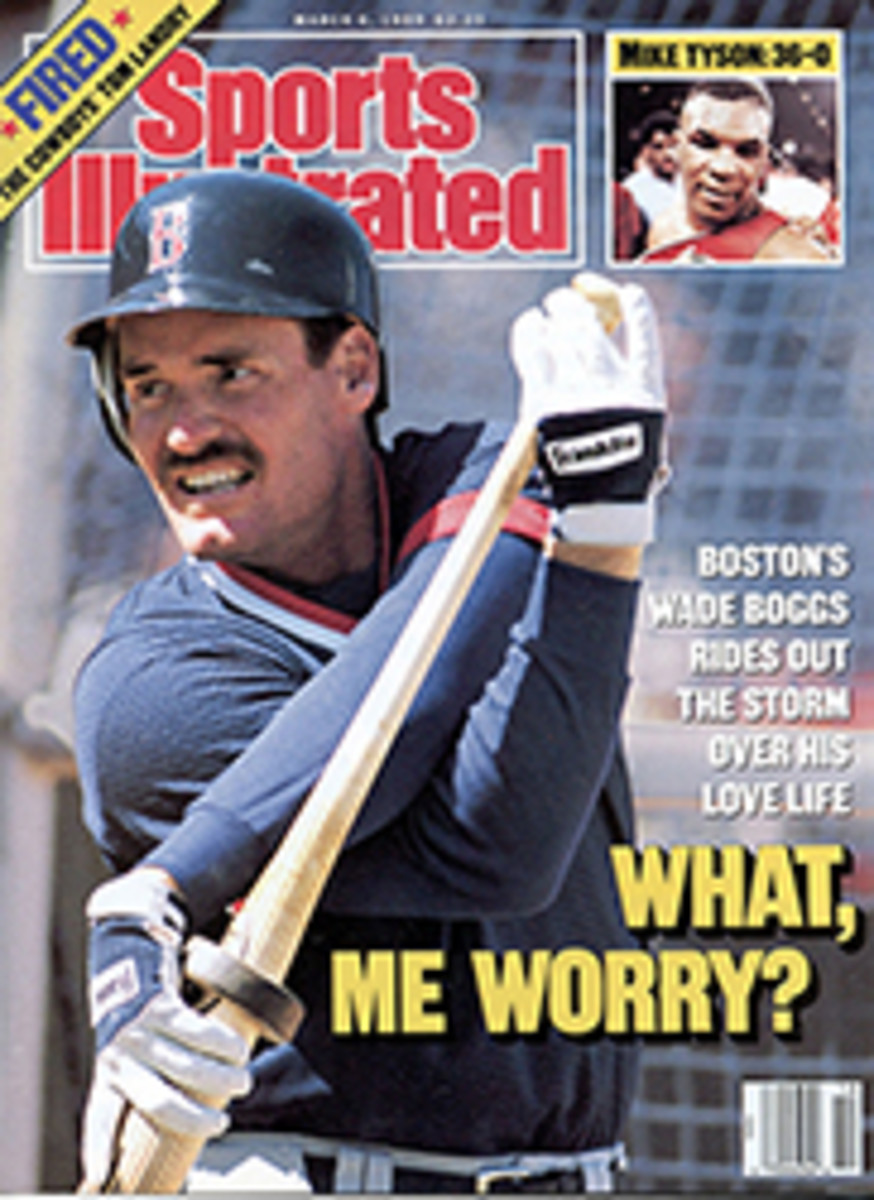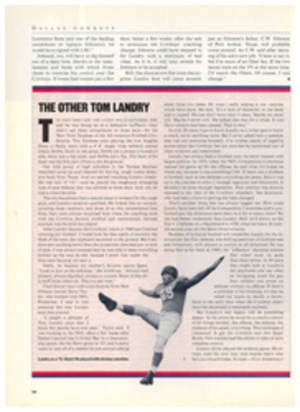
THE OTHER TOM LANDRY
The first time I saw Tom Landry was in September 1949, and he was lining up as a defensive halfback—they didn't call them cornerbacks in those days—for the New York Yankees of the All-America Football Conference. The Yankees were playing the Los Angeles Dons, a flashy team with a 6'4" single wing tailback named Glenn Dobbs. Early in the game, Dobbs ran a sweep to Landry's side, there was a big crash, and Dobbs did a flip. The back of his head was the first part of him to hit the ground.
Our little group of high schoolers in the Yankee Stadium bleachers stood up and cheered for this big, tough rookie defensive back from Texas. And we started watching Landry closely. He was tall—6'1½"—and he played the roughneck strangling type of pass defense that was allowed in those days. And. yes, he was a crowd favorite.
The city has always had a special place in its heart for the tough guys, and Landry certainly qualified. He looked like an octopus, covering those receivers, and those of us who remembered him from then were always surprised later when his coaching style with the Cowboys became cerebral and unemotional, because emotion was his style as a player.
After Landry became the Cowboys' coach in 1960 and I started covering pro football. I would look for that spark of emotion: the flash of the eyes, the clipboard slammed to the ground. But I seldom saw anything more than the occasional clenched jaw or look of pain. I was always amazed that he was able to keep everything bottled up the way he did, because I knew that inside the fires were burning. I'd seen it.
Oddly, he became my mother's favorite sports figure. "Look at him on the sidelines," she would say. "Always well dressed, always dignified, always in control. None of that silly stuff those others do. That's a real man."
I had dinner once with a psychiatrist from New Orleans named Steve Taylor, who worked with NFL Properties. I said it was amazing the way Landry kept that control.
"I caught a glimpse of Tom Landry once that I think few people have ever seen," Taylor said. "I was working in the NFL office a few weeks after Dallas's second loss to Green Bay in a championship game, the Ice Bowl game in '67, and Landry came in, and all of a sudden he just started talking about those two losses. He wasn't really talking to me—anyone would have done. He said, 'It's a lack of character, in the team and in myself. We just don't have what it takes. Maybe we never will. Maybe I never will.' He talked like that for a while. It was like a window had been opened. Then it shut."
In over 20 years, I got to know Landry as a writer gets to know a coach, never anything more. But I never asked him a question that was not answered honestly. I've written plenty of negative stories about the Cowboys, but not once has he mentioned any of them or shown any resentment.
Landry has always been a football man; he never messed with league politics. In 1978, when the NFL Competition Committee opened the game up for the offense, he said what I'd hoped he would say, because it was something I felt: If there was a problem in football, such as the defenses controlling the game, then it was up to the coaches to solve it through ingenuity and brainwork. It shouldn't be done through legislation. That position was directly opposed to the view of the Cowboys' president, Tex Schramm, who had been a force in getting the rules changed.
That's another thing that has always bugged me: How could Landry have been left off the Competition Committee and a non-football guy like Schramm have been on it for so many years? No one had better credentials than Landry. Hell, he'd drawn up the first 4-3 defense on a blackboard in 1950, when he was a 26-year-old second-year pro for Steve Owen's Giants.
Students of technical football will remember Landry for his innovations: the Flex defense; the shifting spectrum of multiple sets and formations, with players in motion in all directions (he was doing that as far back as 1960); his "influence" blocking scheme that relied more on guile than sheer power. In 50 years they might look at Landry's old playbooks and say what an intriguing mind the guy had—solidity and power on defense, trickery on offense. If there's a criticism of his thinking, it's that he relied too much on dazzle, a throwback to the early days when the Cowboys didn't have the personnel to outmuscle anybody.
But Landry's real legacy will be something deeper. In his prime he stood for a coach's control of all things football, the offense, the defense, the makeup of his squad, everything. The loneliness of command. It got the Cowboys into five Super Bowls. Few coaches had the ability to take on such complete control.
Landry never played the political game. He always went his own way, and maybe that's why he's out of a job today. It's sad.
PHOTO
AP
Landry as a '51 Giant: He played with obvious emotion.

